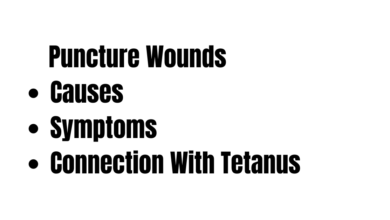Tetanus and Wound Management: Best Practices for Injury Care

Introduction
Tetanus is a potentially life-threatening bacterial infection caused by the Clostridium tetani bacteria. It commonly enters the body through deep wounds and can lead to severe muscle stiffness and spasms. Proper wound management is crucial to prevent tetanus and promote effective healing. In this article, we will explore best practices for wound management and tetanus prevention to ensure optimal care for injuries.
Understanding Tetanus
Tetanus bacteria are commonly found in soil, dust, and animal feces. When they enter the body through a wound, they release toxins that affect the nervous system, causing muscle stiffness and spasms. Tetanus is a medical emergency and requires immediate attention.
Wound Cleaning and Disinfection
Proper wound cleaning and disinfection are essential steps in preventing tetanus and reducing the risk of infection. Here are some best practices for wound management:
- Wash Hands: Before attending to the wound, thoroughly wash your hands with soap and water to minimize the risk of introducing additional bacteria.
- Control Bleeding: Apply gentle pressure to the wound with a clean cloth or sterile dressing to stop bleeding. Elevate the injured area, if possible, to further control bleeding.
- Clean the Wound: Gently clean the wound with mild soap and running water. Avoid using harsh antiseptics or hydrogen peroxide, as they may damage healthy tissue.
- Remove Debris: Carefully remove any visible dirt, debris, or foreign objects from the wound using sterile tweezers or forceps. Be cautious not to push debris further into the wound.
- Irrigate the Wound: If available, use a sterile saline solution or clean water to irrigate the wound. This helps flush out any remaining dirt or bacteria.
- Pat Dry and Cover: After cleaning and irrigation, gently pat the wound dry with a clean towel or sterile gauze. Apply an appropriate dressing or bandage to protect the wound from further contamination.
- Change Dressings: Regularly change dressings according to healthcare professional recommendations to promote wound healing and prevent infection.
Tetanus Vaccination
Vaccination is the primary method of tetanus prevention. The tetanus vaccine stimulates the body’s immune system to produce protective antibodies against the tetanus toxin. Here are key points to know about tetanus vaccination:
- Primary Vaccination: The tetanus vaccine is typically administered in childhood as part of routine immunization schedules. It requires multiple doses to achieve optimal protection.
- Booster Shots: Booster doses are necessary to maintain immunity throughout life. A tetanus booster is recommended every 10 years.
- Wound-Related Vaccination: If you have a deep or dirty wound and it has been more than five years since your last tetanus shot, a tetanus booster may be recommended. Promptly seek medical attention for assessment and guidance.
- Combined Vaccines: Tetanus vaccines are often combined with vaccines for other diseases, such as diphtheria and pertussis (whooping cough). Consult with healthcare professionals to ensure you receive the appropriate vaccinations.
Tetanus Immunoglobulin (TIG)
In certain cases, tetanus immunoglobulin (TIG) may be administered alongside vaccination. TIG provides immediate, temporary protection against tetanus and is recommended for individuals with:
- Uncertain Vaccination History: If your vaccination history is unknown or incomplete, TIG may be administered along with the tetanus vaccine.
- High-Risk Wounds: Deep or contaminated wounds, especially those caused by rusty objects, soil, or animal bites, are considered high-risk for tetanus. TIG may be recommended in such cases.
It is important to note that TIG does not replace the need for tetanus vaccination. Both TIG and tetanus vaccination are often administered simultaneously to provide immediate and long-term protection.
Tetanus and Wound Management FAQs
Q: What are the symptoms of tetanus?
A: Symptoms of tetanus include muscle stiffness and spasms, particularly in the jaw (lockjaw), neck, and abdomen. Other symptoms may include difficulty swallowing, fever, sweating, and rapid heart rate.
Q: How soon should I seek medical attention after a wound?
A: It is advisable to seek medical attention promptly after a wound, especially if it is deep, dirty, or caused by a potentially contaminated object. Healthcare professionals can assess the risk of tetanus and provide appropriate wound care.
Q: Can tetanus be transmitted from person to person?
A: No, tetanus is not transmitted from person to person. It is caused by the introduction of tetanus bacteria into a wound.
Q: Is tetanus fatal?
A: Tetanus can be a life-threatening condition if left untreated. However, with prompt medical care and appropriate wound management, the prognosis is generally favorable.
Q: Can tetanus be prevented by cleaning the wound?
A: While proper wound cleaning is essential to reduce the risk of infection, it cannot guarantee tetanus prevention. Tetanus vaccination is the most effective method of prevention.
Q: Can I get tetanus even if I have received the vaccine?
A: It is possible to contract tetanus even if you have received the vaccine. However, vaccination significantly reduces the risk and severity of the infection.
Conclusion
Proper wound management and tetanus prevention are vital for optimal injury care. By following best practices for wound cleaning, disinfection, and seeking timely medical attention, the risk of tetanus can be minimized. Tetanus vaccination, including booster shots, provides long-term protection against the infection. Remember to consult healthcare professionals for personalized advice and stay up-to-date with your tetanus vaccination. With these best practices, we can ensure the effective management of injuries and reduce the risk of tetanus.




